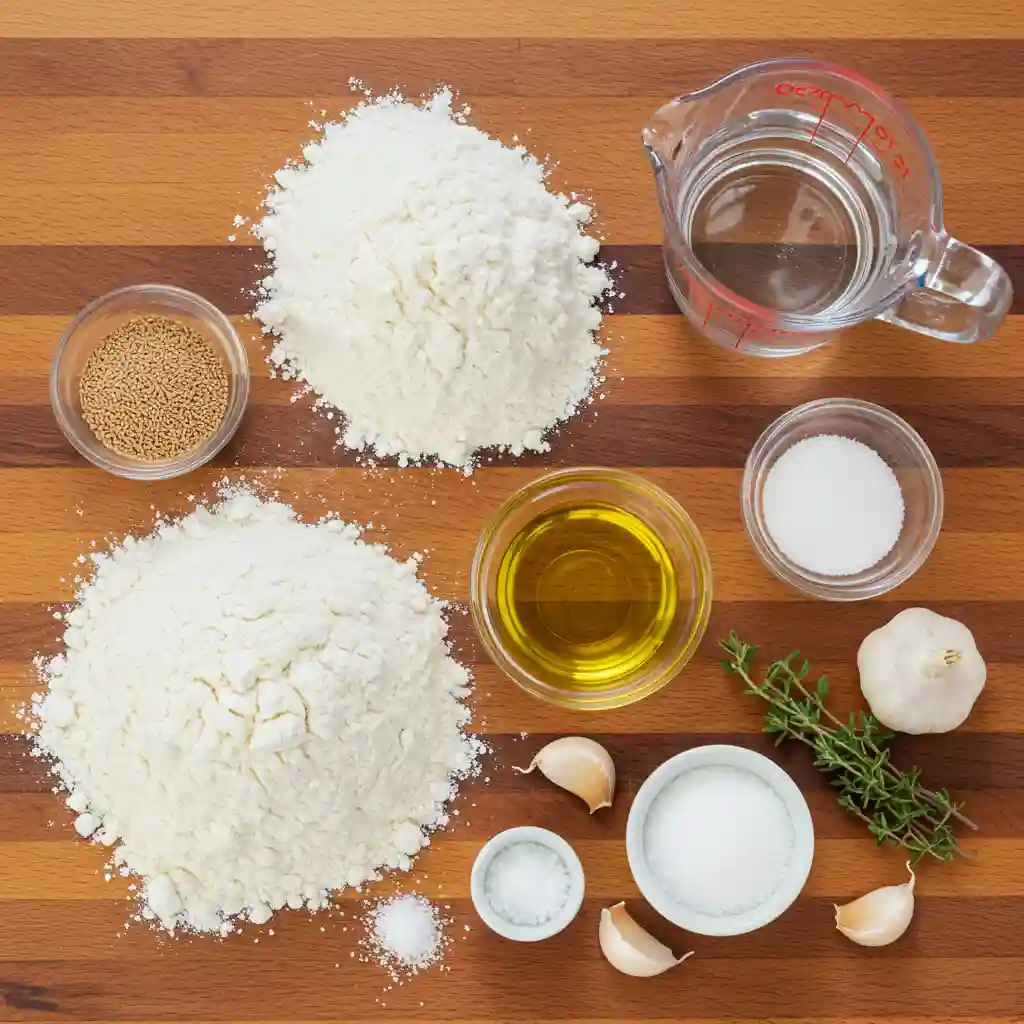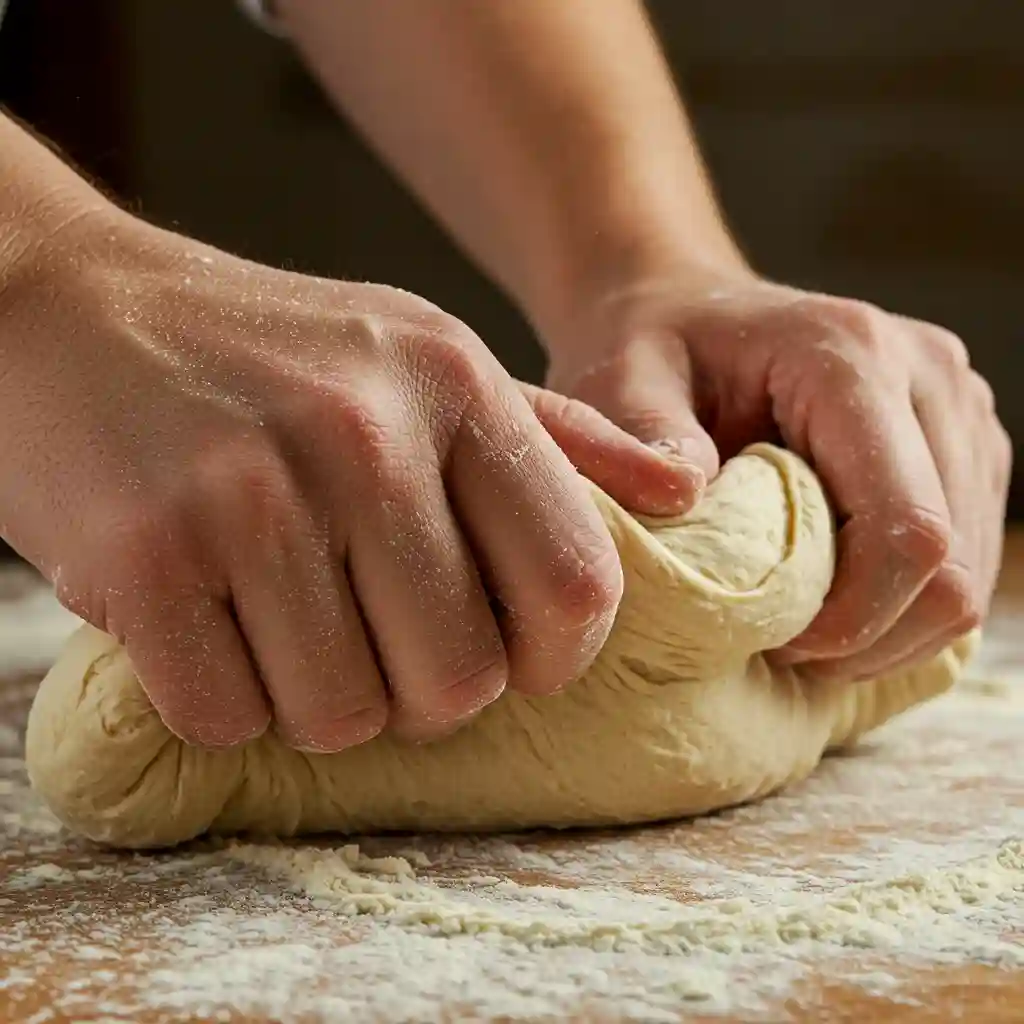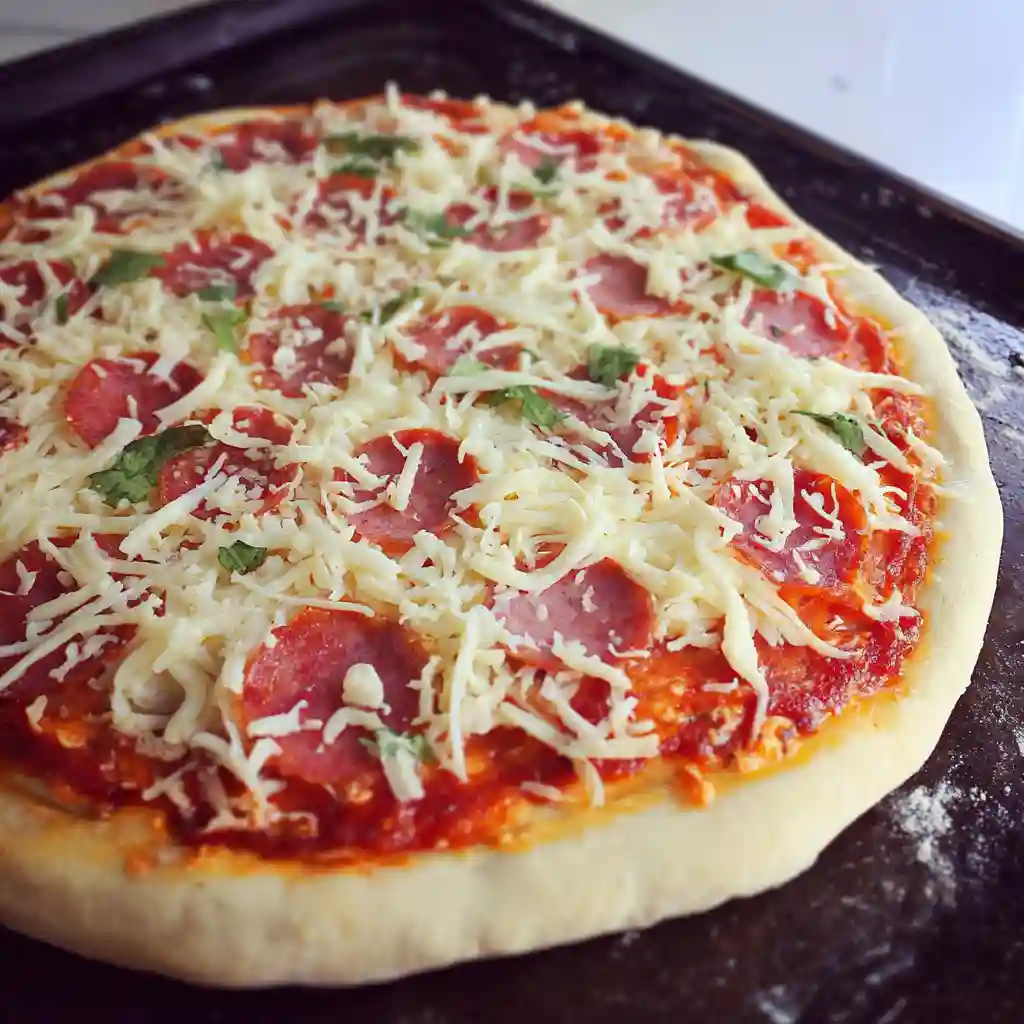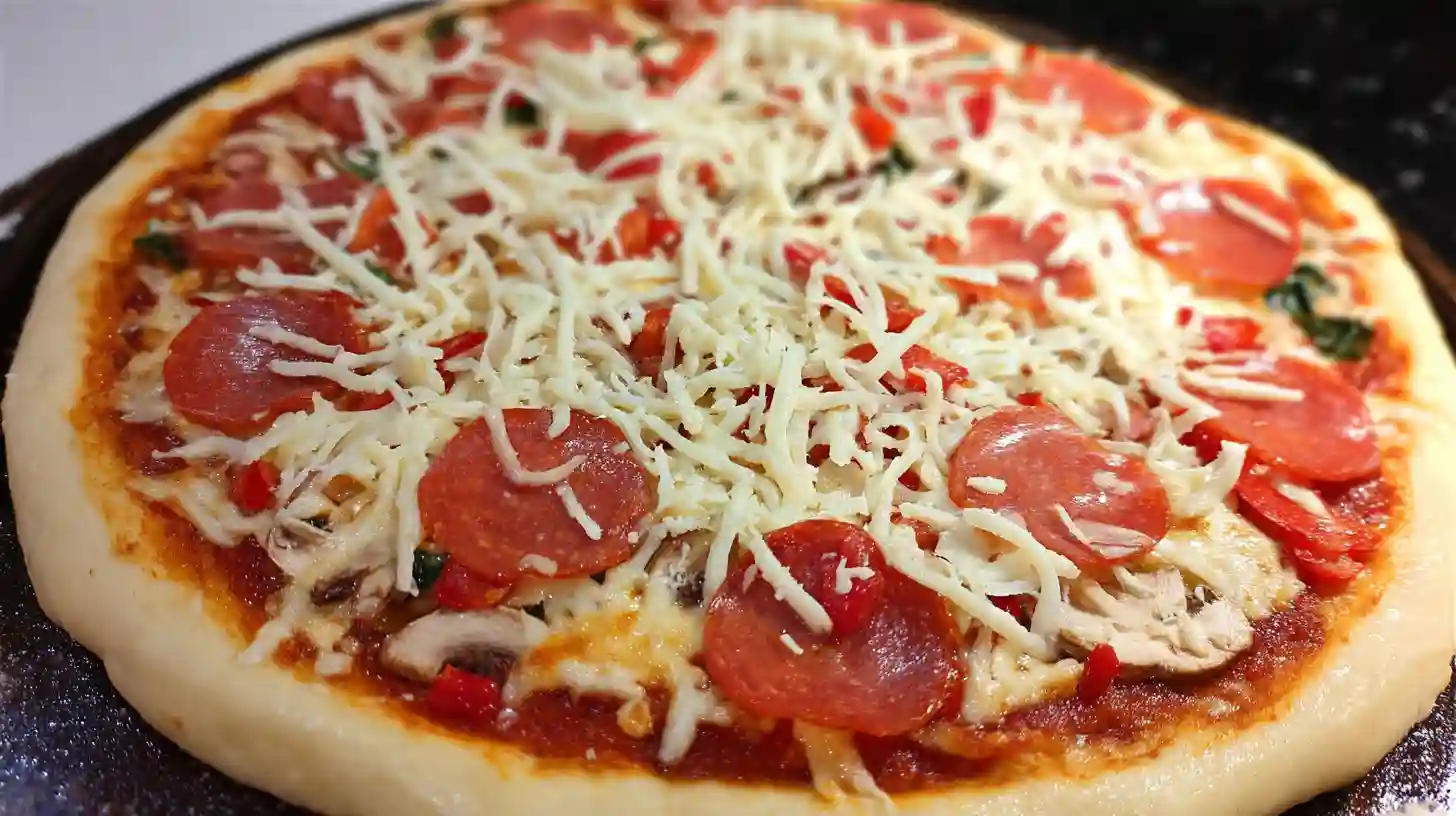Making homemade pizza dough transforms your kitchen into an Italian pizzeria and fills your home with irresistible aromas. This simple pizza dough recipe requires just five basic ingredients you probably already have in your pantry.
I discovered the joy of DIY pizza dough during a rainy Saturday afternoon with my kids. We were craving pizza but didn’t want to order delivery. What started as a fun family activity became our weekly tradition.
The best homemade pizza dough doesn’t require special equipment or professional skills. You need about 10 minutes of active work, then let time do the magic. This easy homemade pizza recipe creates a perfectly chewy crust with crispy edges that rivals any pizzeria.
Whether you’re planning a family dinner or hosting friends, learning how to make your own pizza dough opens up endless possibilities. You control every ingredient, ensuring fresh, preservative-free results every time.
Table of Contents
Ingredients for the Best Easy Pizza Dough
This Italian pizza dough recipe uses simple, quality ingredients that work together to create the perfect texture and flavor.

Essential Ingredients:
3 cups all-purpose flour – Forms the dough’s structure. Bread flour works too for extra chewiness.
1 packet (2¼ teaspoons) active dry yeast – Creates the rise and airy texture. Check the expiration date for best results.
1 teaspoon salt – Enhances flavor and strengthens gluten development.
1 tablespoon sugar – Feeds the yeast and adds subtle sweetness.
2 tablespoons olive oil – Adds richness and helps create a tender crust.
1 cup warm water (110°F) – Activates the yeast. Too hot kills yeast, too cool won’t activate it.
Optional Flavor Boosters:
- 1 teaspoon dried Italian herbs
- 1 clove minced garlic
- 1 tablespoon honey instead of sugar
Instructions: How to Make Homemade Pizza Crust
This fast pizza crust dough recipe takes you from mixing to ready-to-use dough in about an hour.
Step 1: Activate the Yeast
Combine warm water, sugar, and yeast in a large mixing bowl. Stir gently and let sit for 5-10 minutes until foamy. If it doesn’t foam, your yeast might be dead. Start over with fresh yeast.
Step 2: Mix the Dough
Add flour, salt, and olive oil to the yeast mixture. Stir with a wooden spoon until a shaggy dough forms. The mixture will look rough at first.
Step 3: Knead for Perfect Texture
Turn the dough onto a lightly floured surface. Knead for 8-10 minutes until smooth and elastic. The dough should feel slightly tacky but not sticky.
Pro tip: If the dough sticks to your hands, add flour one tablespoon at a time.

Step 4: First Rise
Place dough in an oiled bowl, turning once to coat all sides. Cover with a damp towel or plastic wrap. Let rise in a warm place for 45-60 minutes until doubled in size.
Step 5: Shape and Use
Punch down the risen dough to release air bubbles. Roll out on a floured surface to your desired thickness. Transfer to your pizza pan or baking stone.

Pro Tips and Variations for Making Homemade Pizza Dough
These expert techniques ensure your homemade pizza crust easy recipe succeeds every time.
Professional Tips:
Use a kitchen scale – Measure flour by weight (360 grams) for consistent results. Cup measurements can vary significantly.
Room temperature matters – Cold ingredients slow yeast activity. Let eggs and water come to room temperature before mixing.
Don’t over-flour – Too much flour creates tough, dry dough. Add gradually and only as needed.
Test your yeast – Active yeast creates a foamy crown within 10 minutes. Dead yeast stays flat.
Oil your hands – When shaping sticky dough, oil your palms instead of adding more flour.
Delicious Variations:
Whole Wheat Version – Replace half the all-purpose flour with whole wheat flour. Add an extra 2-3 tablespoons water.
Herb-Infused Dough – Mix in 2 teaspoons dried basil, oregano, or Italian seasoning with the flour.
Garlic Lovers – Add 2 minced garlic cloves and 1 teaspoon garlic powder to the dough.
Thin Crust Style – Divide dough into 2 portions for ultra-thin, crispy crusts.
Deep Dish Adaptation – Use in a greased cast iron skillet for Chicago-style deep dish pizza.
Serving Suggestions for Your Best Pizza Dough Recipe
Your perfectly crafted DIY pizza dough deserves equally delicious toppings and accompaniments.
Classic Pizza Combinations:
Margherita – Fresh mozzarella, tomato sauce, and basil leaves. Simple perfection that highlights your homemade crust.
Pepperoni Supreme – Tomato sauce, mozzarella, pepperoni, bell peppers, and red onions.
White Pizza – Olive oil base with ricotta, mozzarella, garlic, and spinach.
BBQ Chicken – BBQ sauce, grilled chicken, red onions, cilantro, and smoked gouda.
Creative Uses Beyond Pizza:
Calzones – Stuff with ricotta, mozzarella, and your favorite fillings. Seal edges and bake until golden.
Garlic Breadsticks – Roll thin, brush with garlic butter, sprinkle with herbs and parmesan.
Flatbread Appetizers – Top with caramelized onions, goat cheese, and arugula.
Perfect Pairings:
- Fresh Caesar salad with homemade croutons
- Roasted vegetable medley
- Italian antipasto platter
- Chilled white wine or craft beer
Conclusion
Learning how to make homemade pizza dough opens up a world of culinary creativity right in your own kitchen. This easy DIY pizza dough recipe proves that restaurant-quality pizza doesn’t require complicated techniques or expensive ingredients.
The satisfaction of creating something delicious from scratch brings families together and creates lasting memories. Your kitchen will smell amazing, and everyone will be impressed by your homemade pizza crust skills.
This versatile dough recipe adapts to your preferences and dietary needs. Make it ahead for busy weeknights, or turn pizza making into a fun weekend activity with kids.
Once you master this simple technique, you’ll never want to buy frozen pizza again. The fresh flavor, perfect texture, and endless topping possibilities make homemade pizza dough a valuable skill for any home cook.

Homemade Pizza Dough
Ingredients
Method
- In a large mixing bowl, combine warm water, sugar, and yeast. Let sit for 5–10 minutes until foamy.
- Add olive oil, flour, and salt to the yeast mixture. Stir until the dough begins to come together.
- Transfer dough to a floured surface and knead for about 8 minutes, or until smooth and elastic.
- Place the dough in a lightly oiled bowl, cover with plastic wrap, and let rise for 1–1.5 hours until doubled in size.
- Punch down the dough, divide into two equal portions, and shape each into a ball.
- Roll out each dough ball on a floured surface to your desired thickness.
- Preheat oven to 475°F (245°C). Transfer dough to a baking sheet or pizza stone, add toppings, and bake for 12–15 minutes or until crust is golden brown.
Notes
- Calories: 165
- Total Fat: 4g
- Saturated Fat: 0.5g
- Sodium: 390mg
- Total Carbohydrates: 30g
- Dietary Fiber: 1g
- Sugars: 2g
- Protein: 5g
FAQs
Can I make pizza dough ahead of time?
Yes! After the first rise, punch down the dough and refrigerate for up to 3 days. Let it come to room temperature before rolling out. You can also freeze portions for up to 3 months.
Why didn’t my dough rise properly?
Common causes include expired yeast, water too hot or cold, or a too-cool environment. Yeast needs warm (not hot) conditions to activate. Try placing the bowl near a warm oven or sunny window.
How thin should I roll the dough?
For classic pizza, aim for ¼ inch thickness. Thinner creates crispier crust, while thicker makes chewier pizza. Let personal preference guide you.
Can I use instant yeast instead of active dry yeast?
Absolutely! Use the same amount but mix it directly with the flour. You can skip the activation step with warm water.
What’s the best way to store leftover dough?
Wrap tightly in plastic wrap and refrigerate for up to 3 days. For longer storage, freeze in portions. Thaw overnight in the refrigerator before using.
How do I know when the dough has risen enough?
The dough should double in size and feel light and airy. Press two fingers into the center. If the indentations remain, it’s ready.
Can I make this dough without a stand mixer?
Yes! This recipe works perfectly with hand mixing and kneading. It just requires a bit more elbow grease and takes slightly longer to develop the gluten.

Comments are closed.